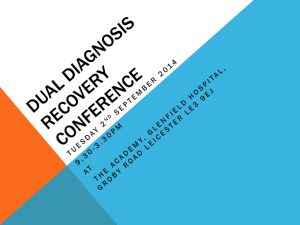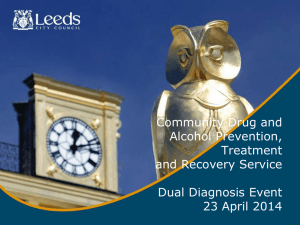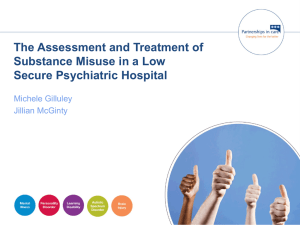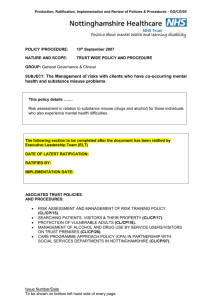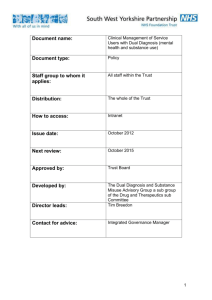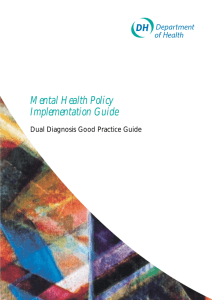model for improved dual diagnosis treatment questionnaire
advertisement
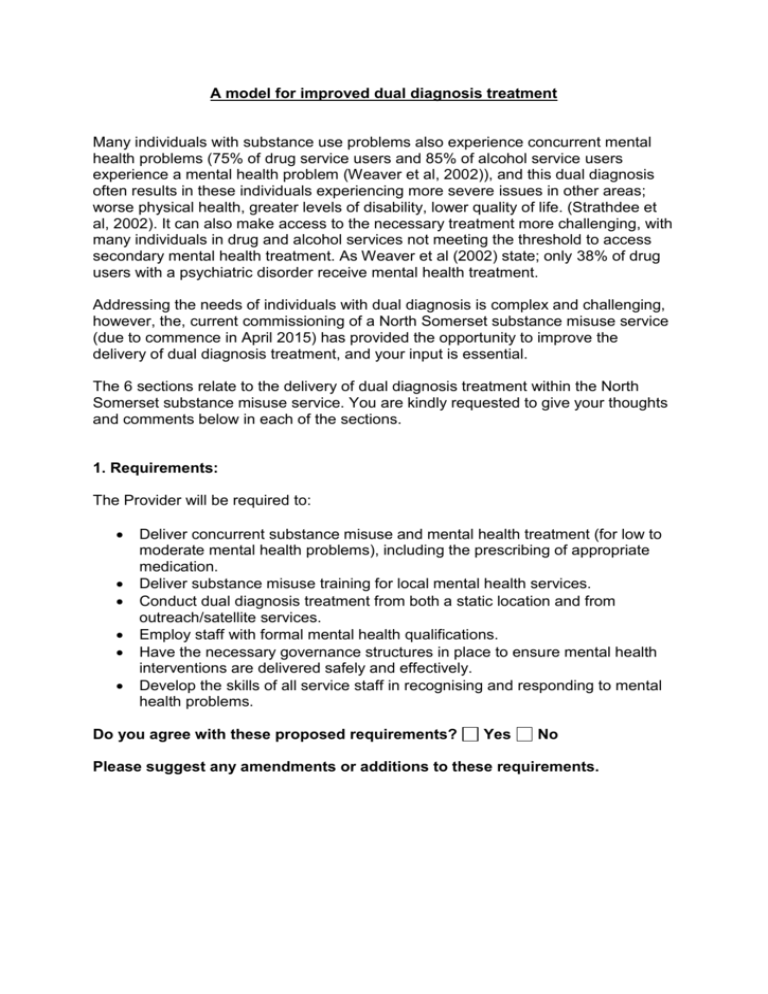
A model for improved dual diagnosis treatment Many individuals with substance use problems also experience concurrent mental health problems (75% of drug service users and 85% of alcohol service users experience a mental health problem (Weaver et al, 2002)), and this dual diagnosis often results in these individuals experiencing more severe issues in other areas; worse physical health, greater levels of disability, lower quality of life. (Strathdee et al, 2002). It can also make access to the necessary treatment more challenging, with many individuals in drug and alcohol services not meeting the threshold to access secondary mental health treatment. As Weaver et al (2002) state; only 38% of drug users with a psychiatric disorder receive mental health treatment. Addressing the needs of individuals with dual diagnosis is complex and challenging, however, the, current commissioning of a North Somerset substance misuse service (due to commence in April 2015) has provided the opportunity to improve the delivery of dual diagnosis treatment, and your input is essential. The 6 sections relate to the delivery of dual diagnosis treatment within the North Somerset substance misuse service. You are kindly requested to give your thoughts and comments below in each of the sections. 1. Requirements: The Provider will be required to: Deliver concurrent substance misuse and mental health treatment (for low to moderate mental health problems), including the prescribing of appropriate medication. Deliver substance misuse training for local mental health services. Conduct dual diagnosis treatment from both a static location and from outreach/satellite services. Employ staff with formal mental health qualifications. Have the necessary governance structures in place to ensure mental health interventions are delivered safely and effectively. Develop the skills of all service staff in recognising and responding to mental health problems. Do you agree with these proposed requirements? Yes No Please suggest any amendments or additions to these requirements. 2. Outcomes: The outcomes to be achieved from the dual diagnosis treatment are: Improved retention in substance misuse treatment for individuals with concurrent mental health problems. Improved substance misuse treatment outcomes for individuals with concurrent mental health problems. Improved joint working between substance misuse services and mental health services. Improved experience of service delivery by individuals with dual diagnosis. Do you agree with these proposed requirements? Yes No Please suggest any amendments or additions to these requirements. 3. Dual diagnosis treatment definition: The Provider, through their bid, will be expected to clearly describe a dual diagnosis treatment package. Do you agree that the Provider should be required to explicitly describe a package of dual diagnosis treatment? Yes No Do you agree that the responsibility for specifying and developing the dual diagnosis treatment should remain with the Provider? Yes No If no, please suggest how the dual diagnosis treatment should be described in the service specification. 4. Defining the mental health issues addressed by the Provider: As stated above, the Provider will be required to address low to moderate mental health issues, these will include: self harm, depression, anxiety, sleep disorders and eating disorders. Do you agree that the service specification should explicitly state a series of mental health conditions that the Provider should address? Yes No If yes, please suggest any amendments or additions to the list of conditions stated above. 5. Handover to primary care or specialist mental health services. There will clearly be a need for the Provider to, at certain times, hand the treatment of mental health conditions over to primary care and/or specialist mental health services. It is suggested that the criteria for handover will be: when the mental health issues exceed the definition of low to moderate, or when the individual is no longer experiencing problematic substance use. Do you agree that handover criteria should be defined in the service specification? Yes No If yes, please suggest any amendments or additions to the suggested criteria for handover outlined above. 6. Dual diagnosis mutual aid. The Provider will be required to develop and support local dual diagnosis mutual aid programmes. Do you agree with this requirement? Yes No If yes, please suggest any amendments or additions you would make. If no, please explain why. Please give details on any existing dual diagnosis mutual aid groups which would be useful to include in the service specification. Please return this form to Ted Sherman, Substance Misuse Manager, North Somerset Council, at ted.sherman@n-somerset.gov.uk by Thursday 31 July.
